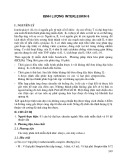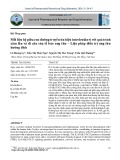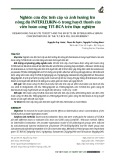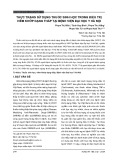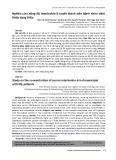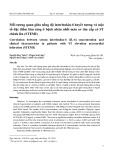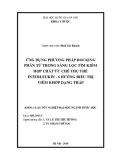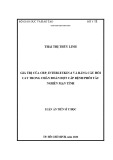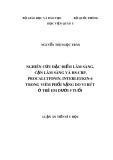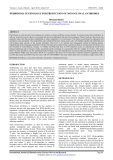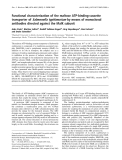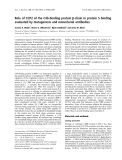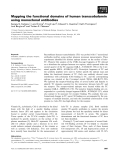Volume 1, Issue 2, March – April 2010; Article 017 ISSN 0976 – 044X
HYBRIDOMA TECHNOLOGY FOR PRODUCTION OF MONOCLONAL ANTIBODIES
Shivanand Pandey Smt. R. B. P. M. Pharmacy College, Atkot-360040, Rajkot, Gujarat. India Email: dot.shivanand@gmail.com
ABSTRACT
Hybridomas are cells that have been engineered to produce a desired antibody in large amounts. To produce monoclonal antibodies, B- cells are removed from the spleen of an animal that has been challenged with the relevant antigen. These B-cells are then fused with myeloma tumor cells that can grow indefinitely in culture (myeloma is a B-cell cancer). This fusion is performed by making the cell membranes more permeable. The fused hybrid cells (called hybridomas), being cancer cells, will multiply rapidly and indefinitely and will produce large amounts of the desired antibodies. They have to be selected and subsequently cloned by limiting dilution. Supplemental media containing Interleukin-6 (such as briclone) are essential for this step.The production of monoclonal anti-bodies was first invented by Cesar Milstein, Georges J. F. Köhler and Niels Kaj Jerne in 1975. Selection occurs via culturing the newly fused primary hybridoma cells in selective-media, specifically media containing 1x concentration HAT for roughly 10–14 days. After using HAT it is often desirable to use HT containing media. Cloning occurs after identification of positive primary hybridoma cells. Clone by limited dilution. While some may believe that IL-6 is essential for this step, it is not necessary to add that expensive supplement, rather use 50% heat-inactivated FBS for the first week. Add 10% FBS DMEM to the clone culture plate after screening for single colony wells.
Keywords: Hybridomas, monoclonal antibodies, Interleukin-6, Supplemental media
INTRODUCTION
anticancer agents, to attack cancer metastases. The monoclonal antibody known as OKT3 is saving organ transplants threatened with rejection, and preventing bone marrow transplants from setting off graft-versus-host disease (immune system series)
METHADOLOGY
A hybridoma, which can be considered as a harry cell, is produced by the injection of a specific antigen into a mouse, procuring the antigen-specific plasma cells (antibody-producing cell) from the mouse's spleen and the subsequent fusion of this cell with a cancerous immune cell called a myeloma cell.
Hybridomas are cells that have been engineered to produce a desired antibody in large amounts, to produce monoclonal antibodies. (1, 2) Monoclonal antibodies can be produced in specialized cells through a technique now popularly known as hybridoma technology.1 Hybridoma technology was discovered in 1975 by two scientists, Georges Kohler of West Germany and Cesar Milstein of Argentina (now working in U.K.), who jointly with Niels Jerne of Denmark (now working in Germany) were awarded the 1984 Noble prize for physiology and medicine.1 Generally, the production of one MAb, using the hybridoma technology, costs between $8,000 and $12,000. The average reasonably SK can generate only 15 to 30 hybridoma fusions per year, but in an environment where the focus is on diagnostic- or therapeutic-quality MAbs, there are additional significant limitations than can further decrease throughput.
The hybrid cell, which is thus produced, can be cloned to produce many identical daughter clones. These daughter clones then secrete the immune cell product. Since these antibodies come from only one type of cell (the hybridoma cell) they are called monoclonal antibodies. The advantage of this process is that it can combine the qualities of the two different types of cells; the ability to grow continually, and to produce large amounts of pure antibody.
HAT medium (Hypoxanthine Aminopetrin Thymidine) is used for preparation of monoclonal antibodies.
Monoclonal antibodies is valuable for the analysis of parasites antigen and appropriate that WHO should have organized a symposium (held at the national university of Singapore, October 1981) which brought together those who have establish and refined the technology and those who are using it, or intending to use it for the study of organism responsible for some of the major diseases affecting mankind.
remarkable new approaches lack the
Laboratory animals (eg. mice) are first exposed to an antigen to which we are interested in isolating an antibody against. Once splenocytes are isolated from the mammal, the B cells are fused with immortalized myeloma cells - HGPRT(hypoxanthine-guanine which phosphoribosyltransferase) gene - using polyethylene glycol or the Sendai virus.
Such monoclonal antibodies, as they are known, have opened to preventing, diagnosing, and treating disease. Monoclonal antibodies are used, for instance, to distinguish subsets of B cells and T cells. This knowledge is helpful not only for basic research but also for identifying different types of leukemias and lymphomas and allowing physicians to tailor treatment accordingly. Quantitating the number of B cells and helper T cells is all-important in immune disorders such as AIDS. Monoclonal antibodies are being used to track cancer antigens and, alone or linked to Fused cells are incubated in the HAT (Hypoxanthine Aminopetrin Thymidine) medium. Aminopterin in the myeloma cells die, as they cannot produce nucleotides by the de novo or salvage medium blocks the pathway that allows for nucleotide synthesis. Hence, unfused D cell die. Unfused B cells die as they have a short life span. Only the
International Journal of Pharmaceutical Sciences Review and Research Page 88 Available online at www.globalresearchonline.net
Volume 1, Issue 2, March – April 2010; Article 017 ISSN 0976 – 044X
positive a B cell-myeloma hybrids survive, since the HGPRT gene coming from the B cells is functional. These cells produce antibodies (a property of B cells) and are immortal (a property of myeloma cells). 2 enzyme labelled conjugate, and chromogenic substrate, is then incubated, and the formation of a colored product hybridoma. Alternatively, indicates immunocytochemical screening can also be used (Nelson et al., 2000.3
The incubated medium is then diluted into multiwell plates to such an extent that each well contains only 1 cell. Then the supernatant in each well can be checked for desired antibody. Since the antibodies in a well are produced by the same B cell, they will be directed towards the same epitope, and are known as monoclonal antibodies.3
identifies and selects only
Multiwell plates are used initially to grow the hybridomas and after selection, are changed to larger tissue culture flasks. This maintains the well being of the hybridomas and provides enough cells for cryopreservation and supernatant for subsequent investigations. The culture supernatant can yield 1to 60 ug/ml of monoclonal antibody, which is maintained at 20°C or lower until required (Nelson et al., 2000.)By using culture supernatant or a purified immunoglobulin preparation, further analysis of a potential monoclonal antibody producing hybridoma can be made in terms of reactivity, specificity, and cross- reactivity (Nelson et al., 2000.)3 Once a hybridoma colony is established, it will continually grow in culture medium like RPMI-1640 (with antibiotics and foetal bovine serum) and produce antibody (Nelson et al., 2000.)3 The next stage is a rapid primary screening those process, which hybridomas that produce antibodies of appropriate specificity. The hybridoma culture supernatant, secondary
These efforts included the following: (6, 7)
(1) The substitution of a chemical fusion promoter (P.E.G.) for the Sendai virus initially used to promote fusion, and
(2) The use of myelomas that do not secrete their own antibodies and that therefore do not interfere with the production of the required antibody
(3) A continuous cell line (Sp 2/0) was used as a fusion partner for the antibody producing B cells.
(4) Feeder layers consisting of extra cells to feed newly formed hybridomas were used for optimal growth and hybridoma production. The most common feeder layers consisted of (6, 7)
Advancements OR Improvements in Hybridoma Technology –
murine peritoneal cells,
to Considerable efforts during the last 10-15 years have been made the yield of monoclonal improve antibodies using hybridoma technology4, 5. marcrophages derived from mouse, rat or guinea pig
International Journal of Pharmaceutical Sciences Review and Research Page 89 Available online at www.globalresearchonline.net
Volume 1, Issue 2, March – April 2010; Article 017 ISSN 0976 – 044X
extra non immunized spleen cells,
Disadvantages of Serum Free Media in Hybridoma Cell Culture and Preparation of Monoclonal Antibodies-
1. Not all serum free media are applicable to all cell lines.
2. Cells may not grow to as high densities and may be more fragile than cells in serum human fibroblasts, human peripheral blood monocytes or thymus cells; these feeder cells had some limitations like depletion of nutrients meant for hybridoma and contamination, so that other sources of hybridoma growth factors (HGF) like interleukin-6 (II-6) derived from human cells were used. 3. Media may take longer to prepare. Purification of Antibodies Bypassing Hybridomas and Cloning of mab Genes –
reaction
Monoclonal antibodies may need to be purified before they are used for a variety of purposes. Before final purification, the cultures may be subjected to cell fractionation for enrichment of the antibody protein. In E. coli, the antibodies may be secreted in the periplasm, which may be used for enrichment of antibody, so that further purification is simplified. Alternatively the antibodies may be purified from cell homogenate or cell debris obtained from the medium. (6, 7) (if derived
Antibodies can be purified by anyone of the following techniques
(I) ion-exchange chromatography;
(ii) antigen affinity chromatography.
Serum Free Media for Bulk Culture of Hybridoma Cells –
The VH and VL genes for antibodies can be amplified through polymerase chain (PCR) using 'universal primers' (universal primers will carry conserved sequences for most antibodies). By building restriction sites in the above primers, the amplified VH and VL genes can also be cloned directly for expression in mammalian cells or bacteria. The raw material for PCR may be hybridomas or B cells, which may be homogeneous from single cells) or heterogeneous. In the latter case, a variety of VH and VL genes will be amplified and will combine at random to produce as many as 106 clones for antibody genes (from 1000 different VH and 1000 different VL genes). These genes will be cloned in a phage and their products (particularly Fab fragments) can be screened for antigen binding activities. From such a large number of combinations in a combatorial library, it is very difficult to recover the original pairs of V genes (e.g. VHa.VLa or VHx.VLx is an original pair: VLy is a new combination VHa). However, the complexity may be reduced by using antigen-selected B lymphocytes (filters coated with antigen can be used for screening). (7)
Designing and Building of mab Genes – to difficulties leads
The antigen binding sites of antibodies have been studied in some detail in recent years. This led to modelling of entirely new antibodies, sometimes for their use as enzymes.
The media for culturing a variety of animal cells and discussed the significance of adding serum to basal nutrient media. Serum is a highly complex and poorly defined mixture of components like albumin, transferrin, factors. lipoproteins and various hormones/growth Nevertheless, serum makes an essential component of media for culturing animal cells. The use of serum, however, in purification of antibodies. Furthers, it is an expensive technology for large scale production of hybridoma cells for industrial production of monoclonal antibodies. In view of these difficulties, serum free media are being increasingly used for culturing hybridoma cells. (6, 7)
Advantages of Serum Free Media in Hybridoma Cell Culture and Preparation of Monoclonal Antibodies: (6, 7) This modelling through computer graphics can be used for alteration of antibody genes or for synthesis of entirely genes. These genes can be cloned and expressed in bacteria. The antibodies produced can be tested for their specificity and affinity for specific antigen. (7)
Primary and Secondary Libraries for Antibody Genes – 1. Greatly simplified purification of antibodies due to increased 1.initial purity and absence of contaminating immunoglobulin.
2. Decreased variability of culture medium.
In this method a repertoire of antibody genes can be prepared by using genes that can be obtained from a number of different sources including the following 3. Reduced risk of infectious agents.
4. Fewer variables for quality control/quality assurance. (i) Rearranged V genes from animals obtained through the use of PCR (with universal primers) 5. Increased control over bioreactor conditions.
6. Potential for increased antibody secretion. (ii) New V genes obtained through gene conversion, a process adopted in birds 7. Low or no dependence on animals.
(iii) Rearranged genes obtained from mRNA through reverse transcription 8. Cost effective.
9. Overall enhanced efficiency
(iv) Designing entirely new V genes or D segments. The next step is to allow the expression of library in bacteria and screen antibodies for antigen binding activities. The
International Journal of Pharmaceutical Sciences Review and Research Page 90 Available online at www.globalresearchonline.net
Volume 1, Issue 2, March – April 2010; Article 017 ISSN 0976 – 044X
produced without hybridomas be screening can be done on membrane filters coated with antigen. In future, the screening procedures may be replaced by methods of selection. In either case the selected VH and VL genes can be subjected to mutations to increase the affinity of an antibody for a specific antigen. A variety of methods for the above strategy are being developed, so that in future monoclonal antibodies will and lymphocytes gens. (6, 7)
MabCure hybridoma technology
is based on
Mabs – Monoclonal antibodies Drawing by Galia Karpol
tumor “manufactures” cells. Each a single Peptide Synthesis for Monoclonal form.
technology exhibits several Classic Hybridoma the technology generation of immortal “hybrid cells” (hybridoma), which follows the fusion of antibody-producing B-cells with myeloma hybridoma type of continuously (“monoclonal”) antibody. MabCure has "re-engineered" the classic hybridoma technology into a highly efficient and optimized one, overcoming the inherent limitations of the former, yet exploits its benefits. MabCure hybridoma important advantages over competing technologies: 8
Prior
is not identity of cancer antigen(s) required for generating Mabs against these antigens. MabCure's approach to creating anti- cancer Mabs is unbiased and enhances the discovery of new cancer markers. to 1mg Custom monoclonal antibody production at Cell Essentials normally takes 4-6 months and is divided into 3 phases. The client has the option of halting the hybridoma production prior to the beginning of the next phase. Cell Essentials will not proceed to the next phase of the project without written (email) confirmation from the client. The client is invoiced for each phase at its initiation. The amount of material needed for immunizations of 5 mice is 1mg to 1.5mg and an additional 0.8mg is needed for ELISA screening.9 Antigens are preserved in
their natural conformations; the resulting Mabs are able to better recognize and bind more selectively to tumor cells.
this Phase Phase I: Immunization of 5 Balb/c mice including preinjection tail bleeds, antigen/adjuvant injections, all antigen/adjuvant boosts, tail bleeds and ELISA to determine highest titer mouse to be used for cell fusion. Time for is ~ 2 months and costs $1,800(USD).
tumor specificity and Unlimited quantities of antibodies produced against a selected cancer target. A large number of antibodies is the key factor for obtaining an antibody repertoire which would tumor exhibit both "universality".
in
Cancer cells have an abundance of normal molecules (antigens) on their surface which are often "over-expressed" compared to normal cells and are also quite immunogenic, i.e. they can trigger robust immune response in the injected animal. Phase II: Fusion of spleen cells with myeloma cell line, plating the fusion product into six 96 well plates, and determination of those wells expressing antibodies to the antigen by ELISA assay. All antibody-secreting colonies are isolated and transferred to a 24 well plate, expanded and a portion frozen. Antibody containing medium (3ml) of up to 12 ELISA-positive preclones* will be shipped to the client for evaluation the client's specific application. Time for this Phase is ~ 3-4 weeks and costs $2,900(USD). 9
In contrast, tumor-specific antigens (TSA) on the surface of the cancer cells are thought to be much less numerous and are often poorly immunogenic (i.e. triggering weak immune response).Consequently, the vast majority of Mabs produced by the injected animals is directed against normal antigens while only a few target the TSA. Therefore, one has to be able to produce copious amounts of Mabs in order to find and select those few which are not only tumor-specific, but also "universal" for that type of cancer. 8
technology
MabCure's proprietary is capable of generating specific monoclonal antibodies (“Mabs”) against a broad spectrum of antigens, including rare and poorly immunogenic antigens, such as those known as “cancer markers”, or tumor specific antigens (“TSA”), presumed to be present on the surface of cancer cells.8 Phase III: Cloning of positive (IgG secreting) wells. A maximum of 5** of the positives selected by the client will be cloned by limiting dilution and isotyped. Clones will be expanded, and 10 vials of each selected clone will be frozen. Medium (10ml) from each clone as well as the frozen vials will be shipped to the client. Time for this Phase is ~ 1.5 to 3 months and costs $2,800(USD). 9 Total Cost per project is $7,500(USD). Additional clones can be isolated and processed as in Phase III for $350(USD)/Clone. The success of a custom hybridoma project is dependent upon the antigenicity of the material supplied by the client. Cell Essentials cannot guarantee that the material supplied by the client will produce an immune response sufficient to warrant proceeding to Phase II. Cell Essentials only guarantees that the antibodies produced by hybridomas developed recognize
International Journal of Pharmaceutical Sciences Review and Research Page 91 Available online at www.globalresearchonline.net
Volume 1, Issue 2, March – April 2010; Article 017 ISSN 0976 – 044X
is dual channel biosensor for
kinetics, rate, off affinity, thermodynamics using the The attana200 automated analysis of biomolecular interactions. Incorporating quartz crystal microbalance (QCM) core technology.the system can be used to determining active specificity, concentrations and crude samples.
The QCM core technology enables not only the study of biomolecules of varying species such as protein, nucleic acid and carbohydrate but also vastly different sizes, ranging from peptide to cells. the immunogen as assayed by ELISA. The client is responsible for determining the utility of these antibodies in their specific applications. All resulting hybridomas, their antibodies, and reagents supplied are solely the property of the client. At the completion of the project, these items will be returned to the client.9 Hybridoma cells are grown at high density in culture flasks or roller bottles. The antibody-containing conditioned medium is recovered, sterile filtered and frozen. Depending on the particular hybridoma, antibody concentration can vary greatly, but averages between 20 and 40 ug/ml. The cost is $1/ml (minimum order 100 ml). 10 QCM technology Monoclonal production:
CellCulture reference
then injected and binding of
Hybridoma cells are grown at high density in culture flasks or roller bottles. The antibody-containing conditioned medium is recovered, sterile filtered and frozen. Depending on the particular hybridoma, antibody concentration can vary greatly, but averages between 20 and 40 ug/ml. The cost is $1/ml (minimum order 100 ml). 9
An antigen is initially immobilized on the sample surface surface, while an appropriate constructed. A new resonance frequency is registered. The antibodies the antibodies to the surface bound antigen increases the mass further, whereupon a new shift in the resonance frequency is registered. If only a measurement of affinity (kD) is required, the interaction is allowed to reach equilibrium. To determine the off rate constant (kd), pure buffer is allowed to flow over the sensor surface, washing away unbound antibody.The surface is then regenerated leaving only immobilized antigen and is ready for injected of a new antibody.(12-18)
Bioreactor: Hybridoma cells are grown in dialysis- based mini-fermentors. This technology produces high density cultures that can be 20 to 30 times that achieved in static cell culture systems. Depending on the particular hybridoma these high density cultures on average produce antibody concentrations of 1 mg/ml. We harvest antibody rich medium over a 5 week period. The cost is $600(USD). 9 peripheral (blast cells in Production of human antibodies: Human antibodies are currently produced by the following methods: (i) fusion of mouse myeloma cells with human lymphocytes blood lymphocytes) (6, 7)
Peptide Purity
Price per amino acid residue: Peptide Quantity
>90%
>95%
98%
(cid:0)20mg to 49mg
$40
$45
Inquire
(ii) Immortalization of human cells by Epstein Barr virus. Both the methods have limitations. Human mouse hybrid cells have a tendency for preferential loss of human chromosomes, making them unstable. Similarly, allow preferential Epstein-Barr virus does not immortalization of blasts engaged in antibody response.
(cid:0)50mg to 100mg
$50
$60
Inquire
>100mg
inquire
inquire
Inquire
In view of these difficulties, humanizing of rodent monoclonal antibodies through genetic engineering is the most practical approach, which is being evolved and used for the production of mouse human chimeric monoclonal antibodies to be used for tumour therapy or for manipulation of human immune system or against surface antigens. The humanized chimeric cell antibodies combine the rodent variable regions with the human constant (or constant + variable) framework regions. Minimum cost for peptide synthesis and purification is $400. For other amounts of peptides and/or purities, please contact us as listed above. 11 Included in the prices listed above are: 1.Synthesis set-up costs and synthesis of the peptide, 2. Reverse-phase HPLC 3. purification of all the crude peptide, 4. Peptide identification by Maldi- TOF mass spectrometer. 5. Analytical reverse-phase HPLC determination of peptide purity the
Copies of synthesis, HPLC and mass spectrometer reports, Additional costs: Shipping the rodent from modifications (i.e., phosphopeptides, Peptide biotinylation, or other labels)
Crude Sample Analysis Made Eseasy
immunogenicity of rodent To further reduce elements, humanized antibodies have been produced, which retain only the antigen binding complementarity determining regions (CDRs) in association with human framework regions. In other approach transgenic mice carrying human genes for V, D, J and C regions have been produced. These can be used for the production of human antibodies directly by hyperimmunization. 19-23
Kenta’s technology At Attana, we have developed a system that makes this possible. This system describe how it can be used in screening of antibodies and determininomateg their off rate in serum containing hybridoma supernant.
Kenta’s technology for the generation and selection of an advanced class of fully human monoclonal antibodies
International Journal of Pharmaceutical Sciences Review and Research Page 92 Available online at www.globalresearchonline.net
Volume 1, Issue 2, March – April 2010; Article 017 ISSN 0976 – 044X
(MAbs) combines the advantages of classical hybridoma technology with a unique specific heteromyeloma fusion cell line. (24) the antibodies recognized the thiazolidine ring or the the conjugated nuclear region of penicillins.
Non Hodgkin’s lymphoma- Rituxan®
Brest cancer- herceptine®.
Inflammatory disease- Infliximab®.
Allergic asthma –omalizumab®
In type -1 diabetes- muromunab®.
Clumping of platelet-Abiciximab®.
Hybridoma secreting MAbs against 17 (17OHP) have been hydroxyprogesterone generated.
Uses of monoclonal antibodies
definite market at a Advantages (24)
Monoclonal antibodies or specific antibodies, arc now an essential tool of much biomedical research and are of great commercial and medical value. For instance, ABO blood groups could be earlier identified with the help of human sera carrying antibodies of known specificity. These human sera in U.K. have been replaced by monoclonal antibodies produced by hybridomas, for the identification of ABO blood groups. Thus the diagnostic and screening value of the monoclonal antibodies through serological tests has been demonstrated. Besides the use of monoclonal in identification of blood groups in UK (UK blood typing), following three uses for monoclonal are described, although, only the first two of these make present: (I) Diagnosis (including ELISA test for detection of viruses and imaging),
1. Kenta has isolated and cultured human hybridomas secreting antigen specific antibodies of IgM, IgG, IgA, and IgE isotypes. (ii) Immunopurification
(iii) Therapy.
CONCLUSION
2. High affinity IgG antibodies are far more efficient in neutralising viruses and preventing infections. In contrast gram-negative bacteria are most efficiently attacked with IgM antibodies targeting the bacterial surface polysaccharides.
3. gM antibodies not only destroy bacterial cells but also promote the removal of bacterial debris from inflammed tissue, which will speed up healing of the affected tissue. Bound IgM antibodies activate the human complement system, which leads to the destruction of bacterial cells.
Antibiotics used in hybridoma technology
and conjugates
ampicillin
In order to evaluate the antigenic contribution of different regions of the penicillin molecule, monoclonal antibodies were raised against amoxicillin-protein their in detail. A random specificities analysed sample of the clones produced was analysed by inhibition-ELISA, using, as a quantitative inhibitors, monomeric conjugates of the to butylamine (BA), following antibiotics amoxicillin (AMP), (AX), benzylpenicillin (BP). There was a high degree of cross reactivity with aminopenicillins, but low or absent cross reactivity with BP. None of In diagnosis, pregnancy can be detected by assaying of hormones with monoclonal. Similarly, pathogens can be detected in a few hours sparing several days of culturing of cells earlier needed. Immunopurification involves separation of one substance from a mixture of very similar molecules. The Company’s patented technology has the capacity to address major industrial needs for a faster, lower cost and better quality process. Many of the steps in making hybridomas are similar to those involved with NeoClone’s ABL-MYC technology. Antibodies are proteins synthesized in blood against specific antigens just to combat and give immunity in blood. They can be collected from the blood serum of an animal. Such antibodies are heterogeneous and contain a mixture of antibodies (i.e., monoclonal antibodies). Therefore, they do not have characteristics of specificity. If a specific lymphocyte, after the isolation and culture in vitro, the becomes capable of producing a single type of antibody which bears specificity against specific antigen. It is known as ‘monoclonal antibodies’. Due to the presence of desired immunity, monoclonal antibodies are used in the diagnosis of diseases.
International Journal of Pharmaceutical Sciences Review and Research Page 93 Available online at www.globalresearchonline.net
Volume 1, Issue 2, March – April 2010; Article 017 ISSN 0976 – 044X
property: case the of REFERENCES
intellectual the hybndoma/monoclonal antibody technique.” Paper presented at the 1987 meeting of the Society for Social Studies of Science, Worcester, MA.
12. Knorr-Cetina, Karin D. 1981 the Manufacture of 1. Bretton, PR, Melamed, MR, Fair, WR, Cote, RJ (1994). Detection of occult micrometastases in the bone marrow of patients with prostate carcinoma. Prostate. 25(2), 108-14. Knowledge. New York: Pergamon Press. 2. http://en.wikipedia.org/wiki/Hybridoma_technology #Method
13. Knorr.Cetina, Karin D. and Michael Mulkay, eds. 1983 Science Observed: Perspectives on the Social Study of Science. London: Sage.
14. Latour, Bruno and Steve Woolgar 1979 Laboratory Life: The Social Construction of Facts. Beverly Hills, CA: Sage undergoing patients high of
3. Franklin, WA, Shpall, EJ, Archer, P, Johnston, CS, Garza-Williams, S, Hami, L, Bitter MA, Bast RC, Jones, RB (1996). Immunocytochemical detection of breast cancer cells in marrow and peripheral blood dose chemotherapy with autologous stem cell support. Breast Cancer Res Treat. 41(1), 1-13.
15. Callon, Michel and Bruno Latour 1986 “Les paradoxes de la modernité: comment concevoir les innovation?” Prospective et Sante Hiver: 13-25.
16. Lynch, Michael 1985 Art and Artifact in Laboratory Science. London: Routledge & Kegan Paul.
4. Ghosh, AK, Spriggs, Al, Taylor-papadimitriou, J and Mason, DY(1983). Immunocytochemical staining of cells in pleural and peritoneal effusions with a panel of monoclonal antibodies. J Clin Pathol, 36,1154- 1164.
17. Lynch, Michael 1982 “Technical Work and Critical Inquiry: Investigations in a Scientific Laboratory.” Social Studies of Science 12:499-533.
5. Kvalheim, G (1996). Detection of occult tumour cells in bone marrow and blood in breast cancer patients—methods and clinical significance. Acta Oncol, 35, 13-8. 18. Art To Science In Tissue Culture 1983 “Cell fusion with P.E.G.: is it reproducible?” Art to Science in Tissue Culture 2:1-2.
6. http://www.molecular-plant-biotechnology.info/hybri doma-and-monoclonal-antibodies-mabs/ raising-the- antibodies.htm 19. Mumford RS, Murphy TV. Antimicrobial resistance in Streptococcus pneumoniae: can immunization prevent its spread. J Invest Med 1994; 42:613-21. 7. Elements of biotechnology, P.K. GUPTA (1st EDITION): 2006-2007, (203-211)
20. Canadian Food Inspection Agency, Animal Diseases Research Institute, P.O. 640, Township Road 9-1, Lethbridge, AB T1J 3Z4, Canada
21. C:\Documents and Settings\Admin\My Documents \Cell Essentials.mht 8. Laboratory for Plague Microbiology, Department of Infectious Diseases, State Research Center for Applied Microbiology and Biotechnology, 142279 Obolensk, Serpukhov District, Moscow Region, Russia 22. http://www.attana.com/attana-files/Articles/Attana- IPT_29.pdf
23. C:\Documents and Settings\Destiny\My Documents infections serious in \History.htm 9. Roilides E, Pizzo PA. Modulation of host defenses by cytokines: evolving adjuncts in prevention and treatment of immuno compromised hosts. Clin Infect Dis 1992;15:508-24. 24. C:\Documents and Settings\Destiny\My Documents \humane hybridoma technology Kenta Biotech.htm
10. Hybridoma Techniques 1980 EMBO, SKMB Course, Basel. Cold Spring Harbor, NY: Cold Spring Harbor Laboratory.
11. Mackenzie, Michael, Alberto Cambrosio, and Peter and “Scientific information Keating 1987
***********
International Journal of Pharmaceutical Sciences Review and Research Page 94 Available online at www.globalresearchonline.net

